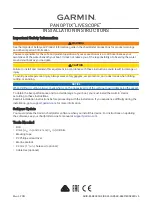
3
M
o
nitoring
Monitoring
LIFEPAK 20e Defibrillator/Monitor Operating Instructions
3-17
©2006-2015 Physio-Control, Inc.
How Capnography Works
An EtCO
2
sensor continuously monitors carbon dioxide (CO
2
) that is inspired and exhaled by the
patient. The sensor employs Microstream non-dispersive infrared (IR) spectroscopy to measure
the concentration of CO
2
molecules that absorb infrared light.
The CO
2
FilterLine system delivers a sample of the exhaled gases directly from the patient into
the CodeManagement Module for CO
2
measurement. The low sampling flow rate (50 ml/min)
reduces liquid and secretion accumulation and prevents obstruction, which maintains the shape
of the CO
2
waveform.
The CO
2
sensor captures a micro sample (15 microliters). This extremely small volume allows for
fast rise time and accurate CO
2
readings, even at high respiration rates.
The Microbeam IR source illuminates the sample cell and the reference cell. This proprietary IR
light source generates only the specific wavelengths characteristic of the CO
2
absorption
spectrum. Therefore, no compensations are required when concentrations of O
2
, anesthetic
agent, or water vapor are present in the exhaled breath.
The LIFEPAK 20e defibrillator/monitor is set at the factory to use the capnography Body
Temperature Pressure Saturated (BTPS) conversion method. This option corrects for the
difference in temperature and moisture between the sampling site and alveoli. The correction
formula is 0.97 x the measured EtCO
2
value. The BTPS conversion can be turned off in the
Setup Options. Refer to
, for more information.
EtCO
2
Monitoring Waveform Analysis
Valuable information concerning the patient’s expired CO
2
can be acquired by examination and
interpretation of the waveform.
The Phases of the Waveform
Figure 3-5 is a graphic representation of a normal capnograph waveform. Four phases of the
waveform require analysis. The flat I–II baseline segment (Respiratory Baseline) represents
continued inhalation of CO
2
-free gas. This value normally is zero. The II–III segment (Expiratory
Upstroke), a sharp rise, represents exhalation of a mixture of dead space gases and alveolar
gases from acini with the shortest transit times. Phase III–IV (Expiratory Plateau) represents the
alveolar plateau, characterized by exhalation of mostly alveolar gas. Point IV is the end-tidal
(EtCO
2
) value that is recorded and displayed by the monitor. Phase IV–V (Inspiratory
Downstroke), a sharp fall, reflects the inhalation of gases that are CO
2
-free. Alterations of the
normal capnograph or EtCO
2
values are the result of changes in metabolism, circulation,
ventilation, or equipment function.
Possible strangulation.
Carefully route the patient tubing (FilterLine) to reduce the possibility of patient entanglement or
strangulation.
Infection hazard
Do not reuse, sterilize, or clean Microstream
®
CO
2
accessories as they are designed for single-
patient one-time use.
Infection hazard
Do not return air from the CO
2
exhaust port to the breathing system.
WARNINGS! (CONTINUED)
Summary of Contents for LIFEPAK 20
Page 2: ...LIFEPAK 20e DEFIBRILLATOR MONITOR Operating Instructions ...
Page 3: ......
Page 4: ...LIFEPAK 20e DEFIBRILLATOR MONITOR OPERATING INSTRUCTIONS ...
Page 15: ......
Page 49: ......
Page 111: ......
Page 155: ......
Page 171: ......
Page 181: ......
Page 183: ......
Page 189: ......
Page 191: ......
Page 195: ......
Page 199: ......
Page 201: ......
Page 205: ......
Page 209: ......
Page 211: ......
Page 213: ......
Page 215: ......
Page 221: ......
Page 226: ......
















































